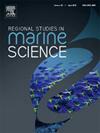当地淡水通量决定了渤海盐度的变化:基于 60 年的观测
IF 2.1
4区 环境科学与生态学
Q3 ECOLOGY
引用次数: 0
摘要
盐度是海水的基本特征之一,对海洋的物理化学特性有重大影响,并直接影响海洋生物多样性及其空间分布。半封闭的渤海是多种海洋生物的家园,也是人类海产养殖的重要区域。该地区的盐度变化对生态系统的稳定性和海洋经济的可持续性至关重要。然而,2007 年冬季渤海的实际盐度测量结果与 2000 年以前广泛使用的国家和国际海洋地图集所记录的结果之间存在明显差异。为了找出这些差异,本研究系统地调查了渤海的盐度变化和调节机制。首先,我们基于 1960-2020 年的原位盐度数据,构建了一个时间范围更广的气候盐度数据集,证实了渤海的气候盐度场并未发生显著的位移,而是呈现出阶段性的变化。随后,利用质量守恒和盐度守恒原理,我们建立了一个盒式模型来分析渤海盐度的年度变化。利用 60 多年的现场水文测量数据和再分析数据对该模型进行了优化,成功揭示了当地淡水通量在渤海盐度年变化中的核心调节作用。此外,我们还阐明了 2007 年冬季渤海盐度异常偏高的原因是连续几年淡水负通量的累积效应。这项研究的结果不仅加深了我们对半封闭海盐度变化的理解和预测,为生态系统的保护和管理提供了科学依据,而且为研究其他半封闭海的长期盐度变化提供了宝贵的启示。本文章由计算机程序翻译,如有差异,请以英文原文为准。
Local freshwater fluxes determine salinity variations of the Bohai Sea: Based on 60 years of observations
Salinity, a fundamental characteristic of seawater, significantly influences the ocean's physicochemical properties and directly affects marine biodiversity and its spatial distribution. The semi-enclosed Bohai Sea is home to diverse marine organisms and serves as a critical area for human mariculture. Salinity variations in this region are crucial for the stability of the ecosystem and the sustainability of the marine economy. However, significant discrepancies have been observed between the practical salinity measurements of the Bohai Sea in winter 2007 and that recorded in widely used national and international marine atlases prior to 2000. To identify these discrepancies, this study systematically investigates the salinity variations and the regulatory mechanisms in the Bohai Sea. First, we constructed a climatological salinity dataset with a broader temporal scope based on in-situ salinity data from 1960 to 2020, confirming that the climatological salinity field of the Bohai Sea did not undergo a significant shift, but exhibited phase changes. Subsequently, using the principles of conservation of mass and salinity, we developed a box model to analyze annual salinity changes in the Bohai Sea. This model was optimized using in-situ hydrological measurements and reanalysis data spanning over 60 years, successfully revealing the central regulatory role of local freshwater fluxes in annual salinity changes in the Bohai Sea. Furthermore, we elucidated that the anomalously high salinity in the Bohai Sea in the winter of 2007 resulted from the cumulative effect of several consecutive years of negative freshwater fluxes. The results of this study not only enhance our understanding and prediction of salinity changes in semi-enclosed seas, providing a scientific basis for ecosystem protection and management, but also offer valuable insights for studying long-term salinity changes in other semi-enclosed seas.
求助全文
通过发布文献求助,成功后即可免费获取论文全文。
去求助
来源期刊

Regional Studies in Marine Science
Agricultural and Biological Sciences-Ecology, Evolution, Behavior and Systematics
CiteScore
3.90
自引率
4.80%
发文量
336
审稿时长
69 days
期刊介绍:
REGIONAL STUDIES IN MARINE SCIENCE will publish scientifically sound papers on regional aspects of maritime and marine resources in estuaries, coastal zones, continental shelf, the seas and oceans.
 求助内容:
求助内容: 应助结果提醒方式:
应助结果提醒方式:


